Paper Menu >>
Journal Menu >>
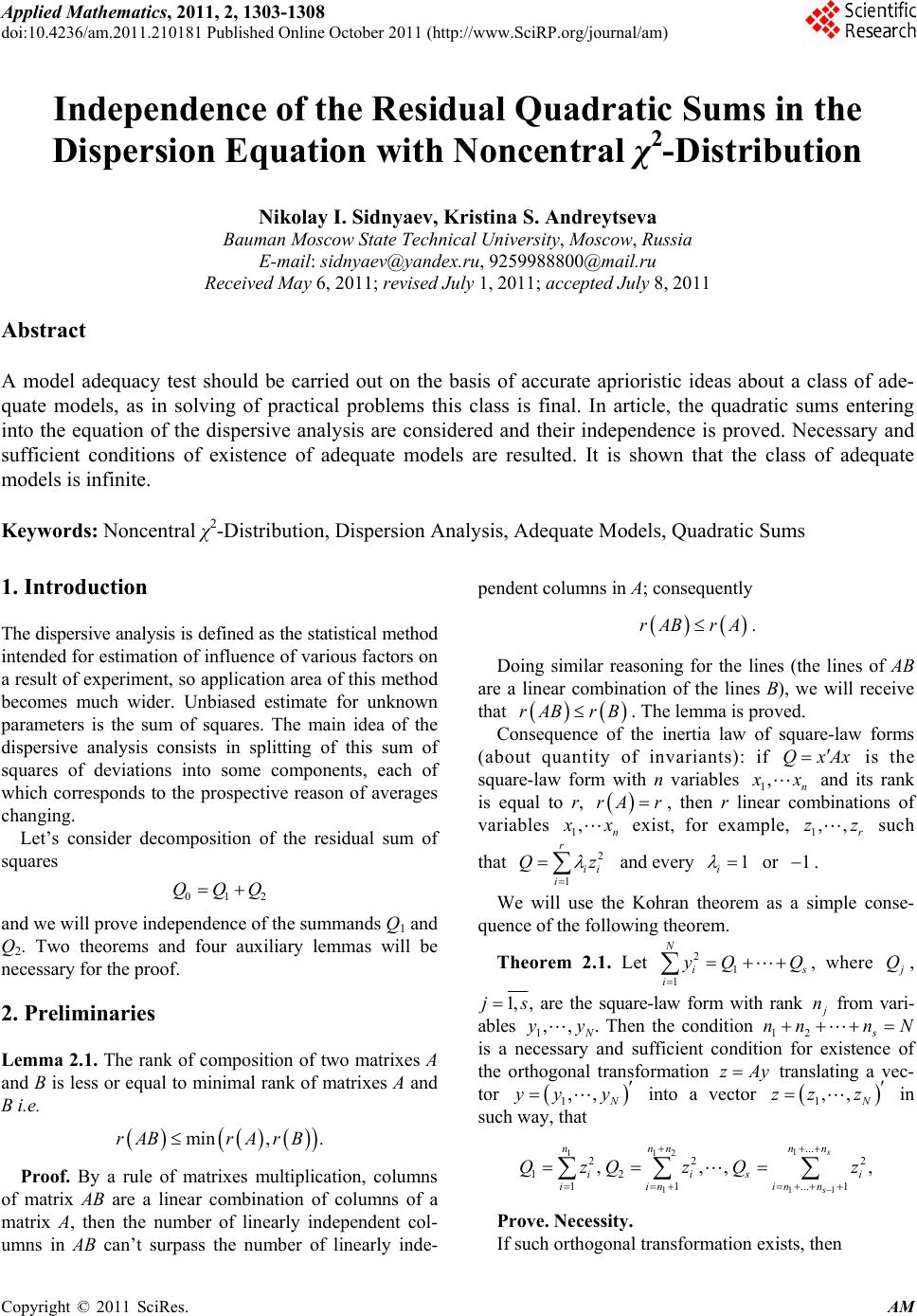 Applied Mathematics, 2011, 2, 1303-1308 doi:10.4236/am.2011.210181 Published Online October 2011 (http://www.SciRP.org/journal/am) Copyright © 2011 SciRes. AM Independence of the Residual Quadratic Sums in the Dispersion Equation with Noncentral χ2-Distribution Nikolay I. Sidnyaev, Kristina S. Andreytseva Bauman Moscow State Technical University, Moscow, Russia E-mail: sidnyaev@yandex.ru, 9259988800@mail.ru Received May 6, 2011; revised July 1, 2011; accepted July 8, 2011 Abstract A model adequacy test should be carried out on the basis of accurate aprioristic ideas about a class of ade- quate models, as in solving of practical problems this class is final. In article, the quadratic sums entering into the equation of the dispersive analysis are considered and their independence is proved. Necessary and sufficient conditions of existence of adequate models are resulted. It is shown that the class of adequate models is infinite. Keywords: Noncentral χ2-Distribution, Dispersion Analysis, Adequate Models, Quadratic Sums 1. Introduction The dispersive analysis is defined as the statistical method intended for estimation of influence of various factors on a result of experiment, so application area of this method becomes much wider. Unbiased estimate for unknown parameters is the sum of squares. The main idea of the dispersive analysis consists in splitting of this sum of squares of deviations into some components, each of which corresponds to the prospective reason of averages changing. Let’s consider decomposition of the residual sum of squares 01 QQQ 2 and we will prove independence of the summands Q1 and Q2. Two theorems and four auxiliary lemmas will be necessary for the proof. 2. Preliminaries Lemma 2.1. The rank of composition of two matrixes A and B is less or equal to minimal rank of matrixes A and B i.e. min, .rABrA rB Proof. By a rule of matrixes multiplication, columns of matrix AB are a linear combination of columns of a matrix A, then the number of linearly independent col- umns in AB can’t surpass the number of linearly inde- pendent columns in A; consequently rAB rA . Doing similar reasoning for the lines (the lines of AB are a linear combination of the lines B), we will receive that rAB rB. The lemma is proved. Consequence of the inertia law of square-law forms (about quantity of invariants): if QxAx n is the square-law form with n variables 1, x x and its rank is equal to r, rA r , then r linear combinations of variables 1,n x x exist, for example, such 1,,zr z that 2 1 ii i Q r z and every 1 i or . 1 s We will use the Kohran theorem as a simple conse- quence of the following theorem. Theorem 2.1. Let , where 2 1 1 N i i yQ Q j Q, 1,js , are the square-law form with rank j n from vari- ables 1,, N yy. Then the condition 12 s nn n N Ay is a necessary and sufficient condition for existence of the orthogonal transformation translating a vec- tor z 1,,yy N y into a vector ,, N z 1 zz in such way, that 1 112 11 ... 22 12 11... 1 ,,, s s nn nnn iis iin inn QzQ zQz 1 2 , i Prove. Necessity. If such orthogonal transformation exists, then 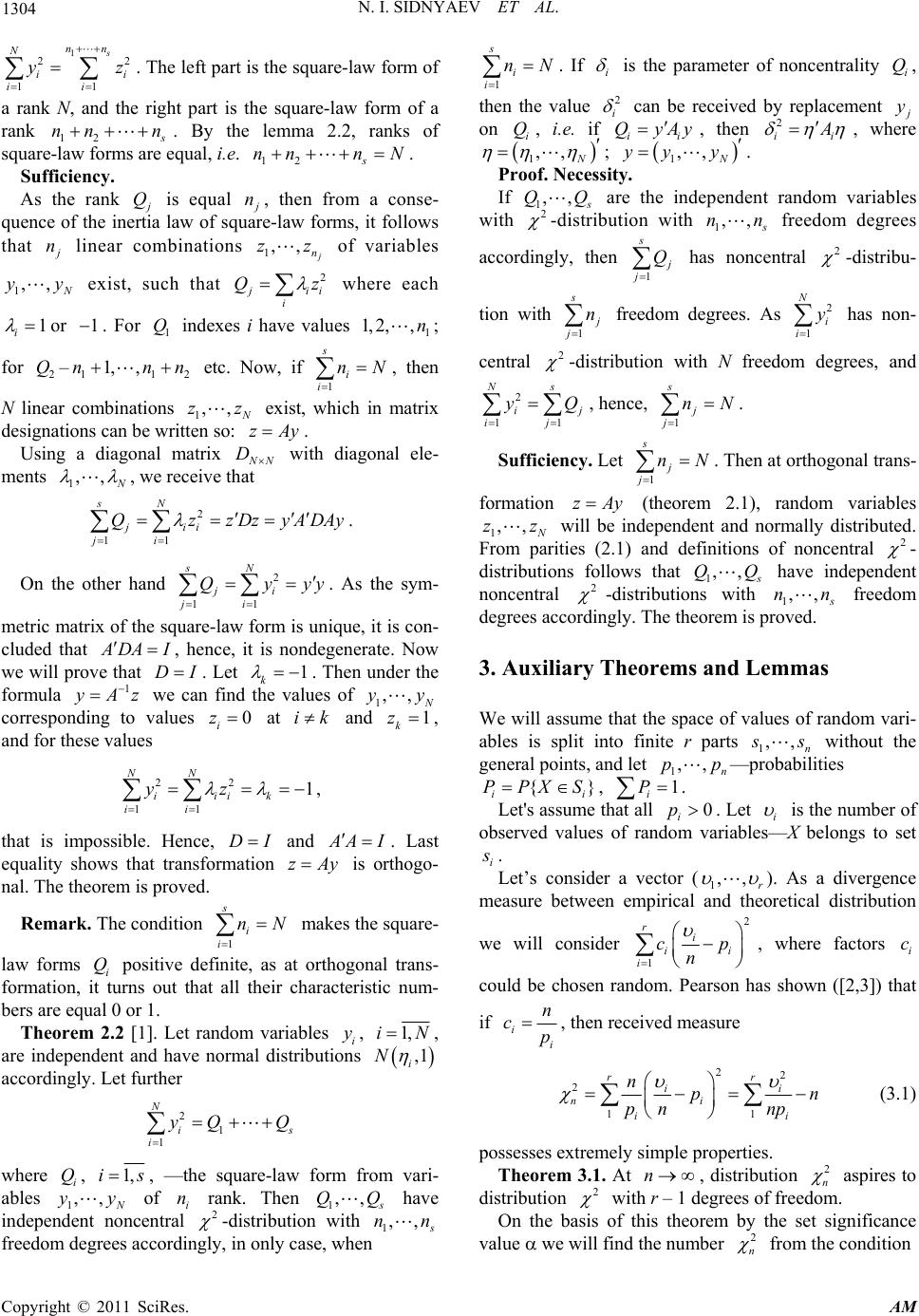 1304 2 i z N. I. SIDNYAEV ET AL. 1 2 11 s nn N i ii y . The left part is the square-law form of a rank N, and the right part is the square-law form of a rank 12 s nn n. By the lemma 2.2, ranks of square-law forms are equal, i.e. . 12 s nnn N Sufficiency. As the rank j Q is equal j n, then from a conse- quence of the inertia law of square-law forms, it follows that j n linear combinations 1,, j n zz of variables 1,, N yy exist, such that 2 j ii i Qz where each 1 i or . For indexes i have values ; for – etc. Now, if , then 1 n 1 Q n 1 1, 2,, n nN 2 Q11 1, ,2 n 1 s i i N linear combinations 1,, N zz exist, which in matrix designations can be written so: . zAy Using a diagonal matrix N N D with diagonal ele- ments 1,, N , we receive that 2 11 sN jii ji QzzDzyAD Ay y . On the other hand . As the sym- 2 11 sN ji ji Qyy metric matrix of the square-law form is unique, it is con- cluded that A DA I D , hence, it is nondegenerate. Now we will prove that . Let I1 k . Then under the formula 1 y Az we can find the values of 1,, N yy corresponding to values 0 i z at and ik1 k z , and for these values 22 11 1 NN iiik ii yz , that is impossible. Hence, and DI A AI . Last equality shows that transformation is orthogo- nal. The theorem is proved. zAy Remark. The condition makes the square- 1 s i i nN law forms i positive definite, as at orthogonal trans- formation, it turns out that all their characteristic num- bers are equal 0 or 1. Q Theorem 2.2 [1]. Let random variables i, y1,iN, are independent and have normal distributions ,1 i N accordingly. Let further 2 1 1 N is i y QQ where , i Q1,i 1 s i i nN . If i is the parameter of noncentrality , i Q then the value i 2 can be received by replacement j y on , i.e. if i Qii QyAy , then 2 ii A , where ,, N 1 ; . N y 1,,yy Proof. Necessity. If 1,, s QQ 2 are the independent random variables with -distribution with 1,, s nn freedom degrees accordingly, then 1 s j j Q has noncentral 2 -distribu- tion with 1 s j j n freedom degrees. As has non- central 2 i y 1 N i 2 -distribution with N freedom degrees, and 2 y 11 j Q Ns i ij , hence, . 1 s j j nN Sufficiency. Let 1 s j j nN . Then at orthogonal trans- formation zAy (theorem 2.1), random variables 1,, N zz will be independent and normally distributed. From parities (2.1) and definitions of noncentral 2 - distributions follows that 1,, s QQ have independent noncentral 2 -distributions with 1,, s nn freedom degrees accordingly. The theorem is proved. 3. Auxiliary Theorems and Lemmas We will assume that the space of values of random vari- ables is split into finite r parts 1,, n s s without the general points, and let —probabilities 1,, n pp {} ii PPXS , 1 i P . Let's assume that all i. Let i 0p is the number of observed values of random variables—X belongs to set i s . Let’s consider a vector (1,, r ). As a divergence measure between empirical and theoretical distribution we will consider 2 1 r i ii i cp n , where factors could be chosen random. Pearson has shown ([2,3]) that if i c i i n cp , then received measure 22 2 11 rr i ni ii np pn np i n (3.1) possesses extremely simple properties. s, —the square-law form from vari- ables 1,, N yy of i rank. Then 1 n,, s QQ have independent noncentral 2 -distribution with 1,, s nn freedom degrees accordingly, in only case, when Theorem 3.1. At , distribution n 2 n aspires to distribution 2 with r – 1 degrees of freedom. On the basis of this theorem by the set significance value we will find the number 2 n from the condition Copyright © 2011 SciRes. AM 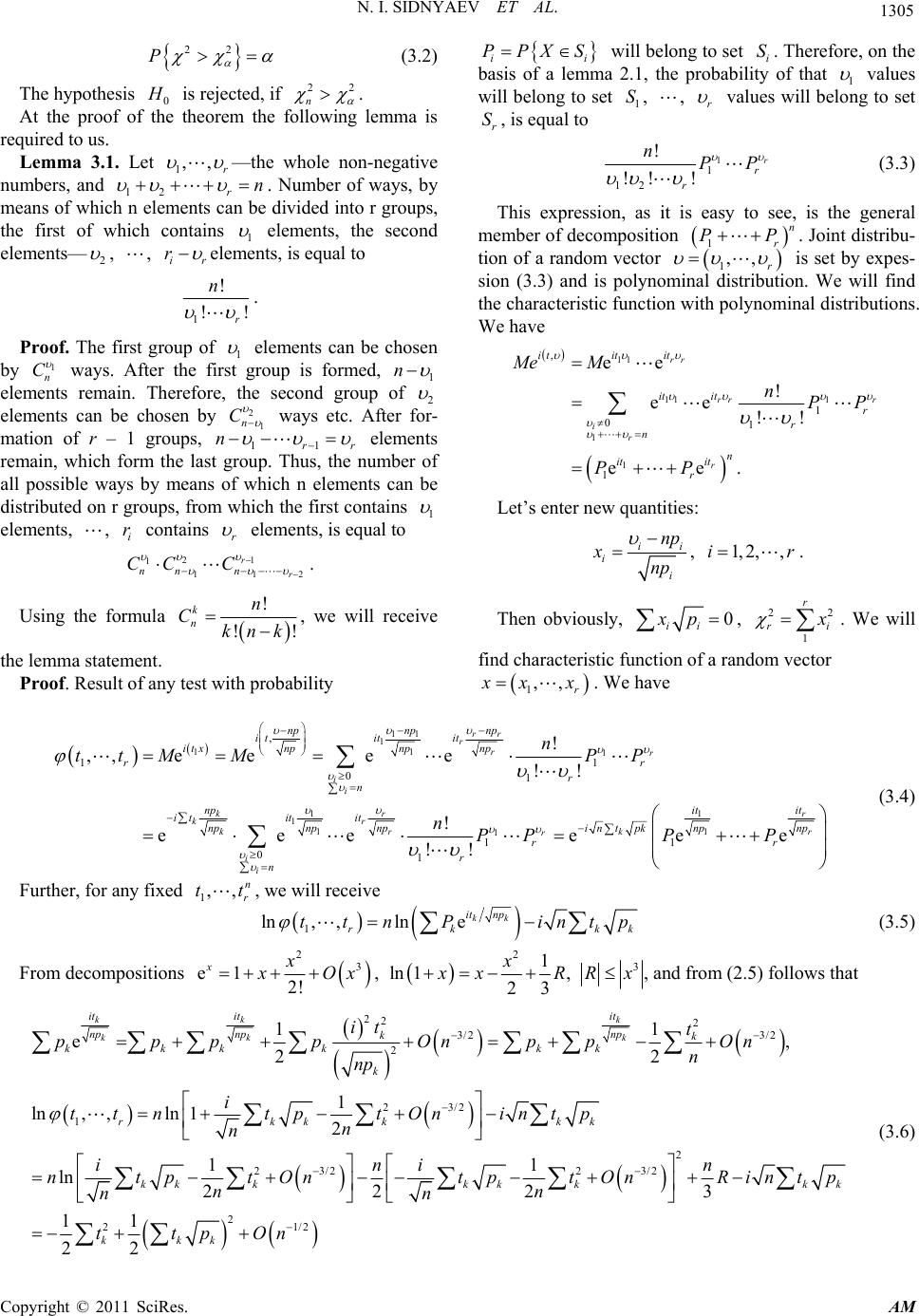 N. I. SIDNYAEV ET AL. Copyright © 2011 SciRes. AM 1305 22 P (3.2) i PPXS i will belong to set i. Therefore, on the basis of a lemma 2.1, the probability of that 1 S values will belong to set , , 1 Sr values will belong to set , is equal to r S The hypothesis 0 H is rejected, if 22 n . At the proof of the theorem the following lemma is required to us. 1 1 12 ! !! ! r r r nPP (3.3) Lemma 3.1. Let 1,, r —the whole non-negative numbers, and 12rn . Number of ways, by means of which n elements can be divided into r groups, the first of which contains 1 elements, the second elements— 2 , , ir r elements, is equal to This expression, as it is easy to see, is the general member of decomposition . Joint distribu- tion of a random vector 1 n r PP 1,, r is set by expes- sion (3.3) and is polynominal distribution. We will find the characteristic function with polynominal distributions. We have 1 ! !! r n . Proof. The first group of 1 elements can be chosen by 1 n C ways. After the first group is formed, 1 n elements remain. Therefore, the second group of 2 elements can be chosen by 2 1 n C ways etc. After for- mation of r – 1 groups, 11rr n elements remain, which form the last group. Thus, the number of all possible ways by means of which n elements can be distributed on r groups, from which the first contains 1 elements, , contains i rr elements, is equal to 11 11 1 1 1 , 1 01 1 ee ! ee !! ee. rr rr r i r r it it it it it r r n n it it r Me M nPP PP Let’s enter new quantities: ii i i np xnp , . 1,2,,ir 21 1 11 r r nnn CC C 2 . Using the formula ! !! k n n Cknk , we will receive Then obviously, 0 ii xp , 2 1 r r 2 i x . We will find characteristic function of a random vector the lemma statement. 1,, r x xx. We have Proof. Result of any test with probability 11 1 11 1 1 1 1 1 1 1 , 1 1 01 11 01 ! ,, eeee!! ! eee ee !! rr r rr i i kr r kr kr r k r i i npnp np it it it np itxnp np r r r n np it it it it it np np npnpnp in tpk rr r n n ttMMPP nPPPP e (3.4) Further, for any fixed , we will receive 1,, n r tt 1 ln,,lne kk it np rk k ttn Pintp k (3.5) From decompositions 2 3 e1 2! xx x Ox, 21 ln 123 x x xR, 3 Rx, and from (2.5) follows that 222 3/2 3/2 2 23/2 1 2 23/2 23/2 11 e , 22 1 ln,,ln 12 11 ln 2223 kk k kk k it itit np npnp kk kkk kkk k rkkk kk kkkkk k it t ppppOnp pOn n np i ttntptOn intp n n ini n ntptOntptOn Rin nn nn 2 21/2 11 22 kk kkk tp ttpOn (3.6) 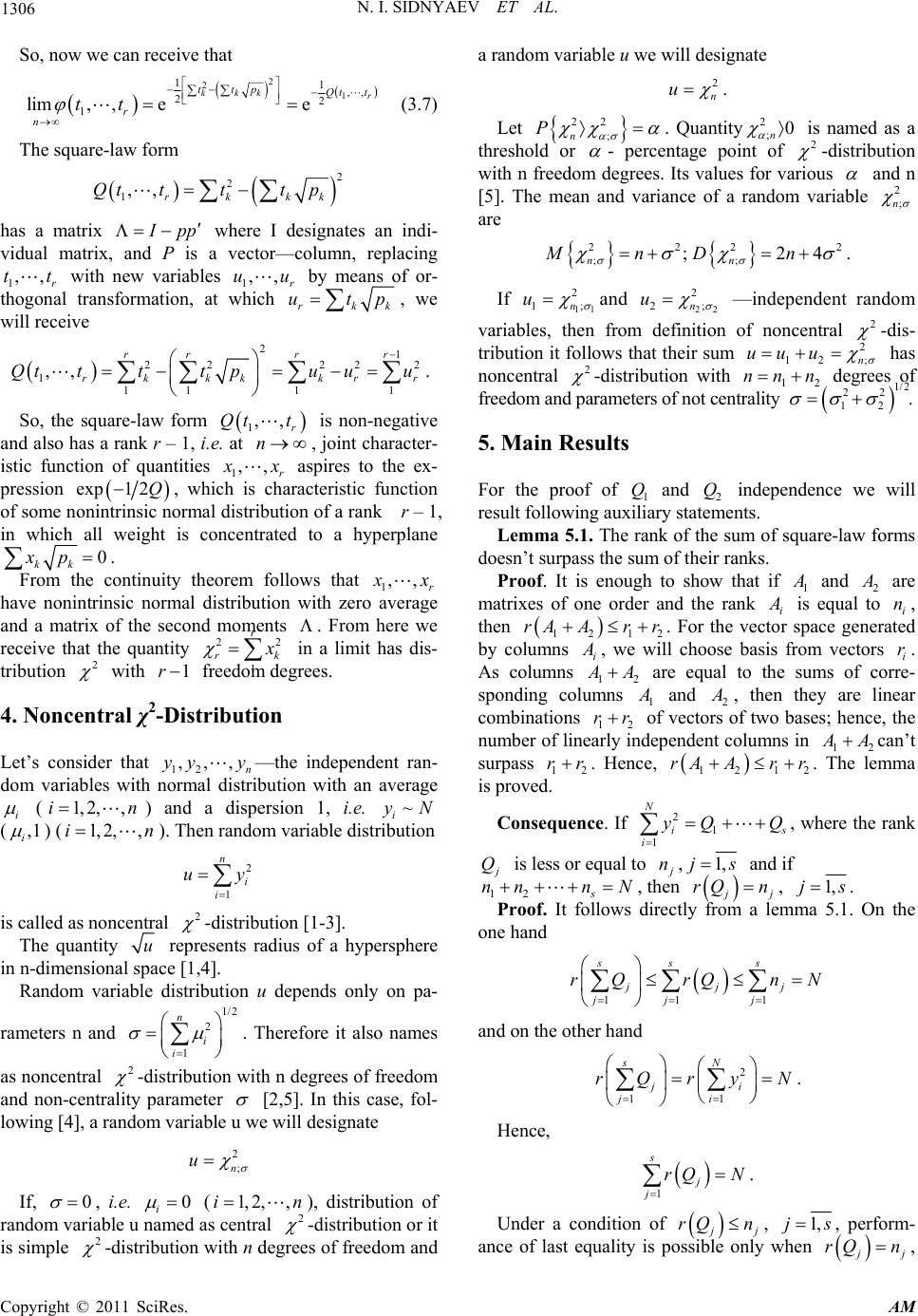 1306 N. I. SIDNYAEV ET AL. So, now we can receive that 2 2 1 11,, 22 1 lim, ,ee kkk r ttp Qt t r n tt (3.7) The square-law form 2 2 1,, rkkk Qtttt p has a matrix I pp where I designates an indi- vidual matrix, and P is a vector—column, replacing 1r with new variables 1 by means of or- thogonal transformation, at which ,,tt,, r uu rk utpk , we will receive 21 22 22 1 111 1 ,, rrr r rkkk kr Qttttpu uu 2 r . So, the square-law form 1,, r Qt t n ,, r is non-negative and also has a rank r – 1, i.e. at , joint character- istic function of quantities 1 x x aspires to the ex- pression exp1 2Q , which is characteristic function of some nonintrinsic normal distribution of a rank r – 1, in which all weight is concentrated to a hyperplane 0 kk xp . From the continuity theorem follows that 1,, r x x have nonintrinsic normal distribution with zero average and a matrix of the second moments . From here we receive that the quantity 1 k 22 r r x in a limit has dis- tribution 2 with freedom degrees. 1r 4. Noncentral χ2-Distribution Let’s consider that 12 —the independent ran- dom variables with normal distribution with an average ,,, n yy y i () and a dispersion 1, i.e. ( 1, 2,,in~ i yN ,1 i ) (). Then random variable distribution 1, 2,,in 2 1 n i i uy is called as noncentral 2 -distribution [1-3]. The quantity u represents radius of a hypersphere in n-dimensional space [1,4]. Random variable distribution u depends only on pa- rameters n and . Therefore it also names 1/2 2 1 n i i 2 as noncentral -distribution with n degrees of freedom and non-centrality parameter [2,5]. In this case, fol- lowing [4], a random variable u we will designate 2 ; n u If, 0 , i.e. 0 i (), distribution of random variable u named as central 1, 2,,i 2 n -distribution or it is simple 2 -distribution with n degrees of freedom and a random variable u we will designate 2 n u . Let 22 P ; n . Quantity;n is named as a threshold or 20 - percentage point of 2 -distribution with n freedom degrees. Its values for various and n [5]. The mean and variance of a random variable 2 ; n are 222 ;; ;2 nn MnD n 2 4 . If 11 2 1; n u and 22 2 2; n u —independent random variables, then from definition of noncentral 2 -dis- tribution it follows that their sum 2 ; n 12 uu u has noncentral 2 -distribution with 12 of freedom and parameters of not centrality nn n degrees 1/ 2 2 1 2 2 . 5. Main Results For the proof of 1 Q and 2 independence we will result following auxiliary statements. Q Lemma 5.1. The rank of the sum of square-law forms doesn’t surpass the sum of their ranks. Proof. It is enough to show that if 1 A and 2 A are matrixes of one order and the rank i A is equal to i, then n 121 rAAr r 2 i . For the vector space generated by columns A , we will choose basis from vectors i. As columns 1 r 2 A A are equal to the sums of corre- sponding columns 1 A and 2 A , then they are linear combinations 12 rr of vectors of two bases; hence, the number of linearly independent columns in 12 A A can’t surpass 12 rr . Hence, rA 12 A1 r 2 r. The lemma is proved. Consequence. If 2 1 1 N i i s y Q Q , where the rank j Q is less or equal to j n,1,js and if 1 nnn N 2s , then j j rQ n, 1,js. Proof. It follows directly from a lemma 5.1. On the one hand 11 1 ss s jjj jj j rQrQ nN and on the other hand 2 11 sN ji ji rQ r yN . Hence, 1 s j j rQ N . Under a condition of j j, rQ n1,j,s perform- ance of last equality is possible only when j j rQ n , Copyright © 2011 SciRes. AM 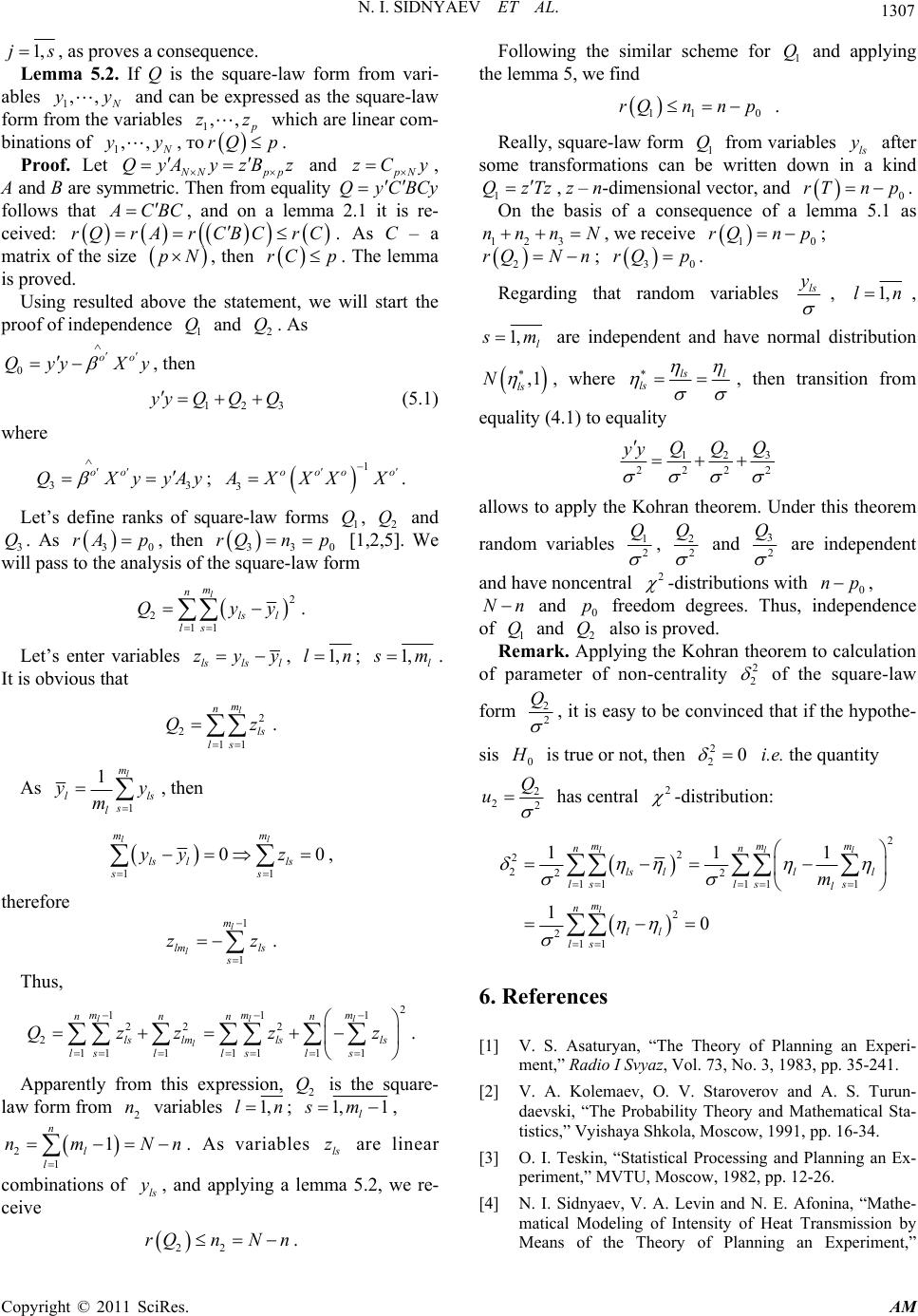 N. I. SIDNYAEV ET AL. 1307 1,js , as proves a consequence. Lemma 5.2. If Q is the square-law form from vari- ables 1,, N yy and can be expressed as the square-law form from the variables 1,, p zz which are linear com- binations of 1,, N yy Qy , то . rQ A yz p B Proof. Let NNpp and z pN zCy , A and B are symmetric. Then from equality QyCBCy follows that A CBC rAr CBCr pN rC , and on a lemma 2.1 it is re- ceived: . As C – a matrix of the size , then . The lemma is proved. rQ C p Using resulted above the statement, we will start the proof of independence and . As 1 Q2 Q 0 oo QyyX y 3 , then 12 yy QQQ (5.1) where 33 oo QXyyA y 1 3 oooo ; A XXX X . Let’s define ranks of square-law forms 1, 2 and 3. As 0 , then Q Q Q 3 rA p 33 rQnp 0 1,2,5. We will pass to the analysis of the square-law form 2 2 11 l m n ls l ls Qy y. Let’s enter variables lsls l zyy, 1,ln; 1,l s m. It is obvious that 2 2 11 l m n ls ls Qz . As 1 1l m ll s l yy m s , then 11 00 ll mm ls lls ss yy z , therefore 1 1 l l m lm ls s zz . Thus, 2 11 22 2 2 1111111 ll l mm nnnn ls lmlsls lsllsls Qzzzz 1 l m . Apparently from this expression, is the square- law form from variables 2 Q 2 n1,ln; 1, 1 l sm , 2 1 1 n l l nmN n. As variables are linear ls z combinations of , and applying a lemma 5.2, we re- ceive ls y 22 rQnN n. Following the similar scheme for and applying the lemma 5, we find 1 Q 11 rQnnp 0 . Really, square-law form 1 from variables ls after some transformations can be written down in a kind Q y 1 QzTz , z – n-dimensional vector, and 0 rT pn . On the basis of a consequence of a lemma 5.1 as 123 nnn N , we receive ; 10 rQnp rQN n 2 ; 30 rQ p . Regarding that random variables ls y , 1,ln, 1, l s m are independent and have normal distribution ,1 ls N , where ls l ls , then transition from equality (4.1) to equality 3 12 222 Q QQ yy 2 allows to apply the Kohran theorem. Under this theorem random variables 1 2 Q , 2 2 Q and 3 2 Q are independent and have noncentral 2 -distributions with 0 np , Nn and freedom degrees. Thus, independence of and Q also is proved. 0 p 1 2 Remark. Applying the Kohran theorem to calculation of parameter of non-centrality Q 2 2 of the square-law form 2 2 Q , it is easy to be convinced that if the hypothe- sis 0 H is true or not, then i.e. the quantity 2 20 2 2 Q 2 u has central 2 -distribution: 2 2 2 222 1111 1 2 2 11 11 10 ll l mm nn ls lll lsls s l m n ll ls m 1 l m 6. References [1] V. S. Asaturyan, “The Theory of Planning an Experi- ment,” Radio I Svyaz, Vol. 73, No. 3, 1983, pp. 35-241. [2] V. A. Kolemaev, O. V. Staroverov and A. S. Turun- daevski, “The Probability Theory and Mathematical Sta- tistics,” Vyishaya Shkola, Moscow, 1991, pp. 16-34. [3] O. I. Teskin, “Statistical Processing and Planning an Ex- periment,” MVTU, Moscow, 1982, pp. 12-26. [4] N. I. Sidnyaev, V. A. Levin and N. E. Afonina, “Mathe- matical Modeling of Intensity of Heat Transmission by Means of the Theory of Planning an Experiment,” Copyright © 2011 SciRes. AM 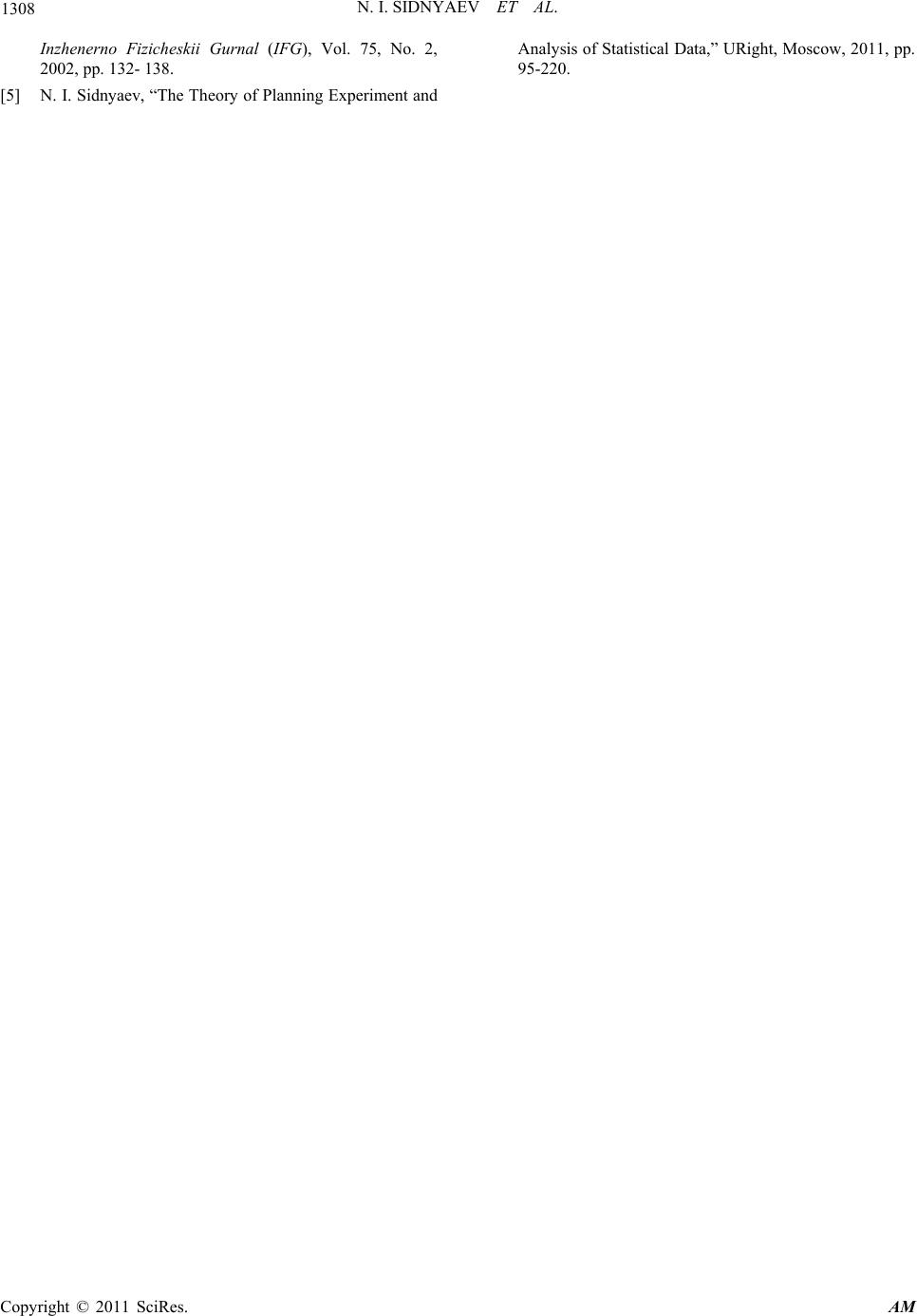 N. I. SIDNYAEV ET AL. Copyright © 2011 SciRes. AM 1308 Inzhenerno Fizicheskii Gurnal (IFG), Vol. 75, No. 2, 2002, pp. 132- 138. [5] N. I. Sidnyaev, “The Theory of Planning Experiment and Analysis of Statistical Data,” URight, Moscow, 2011, pp. 95-220. |

